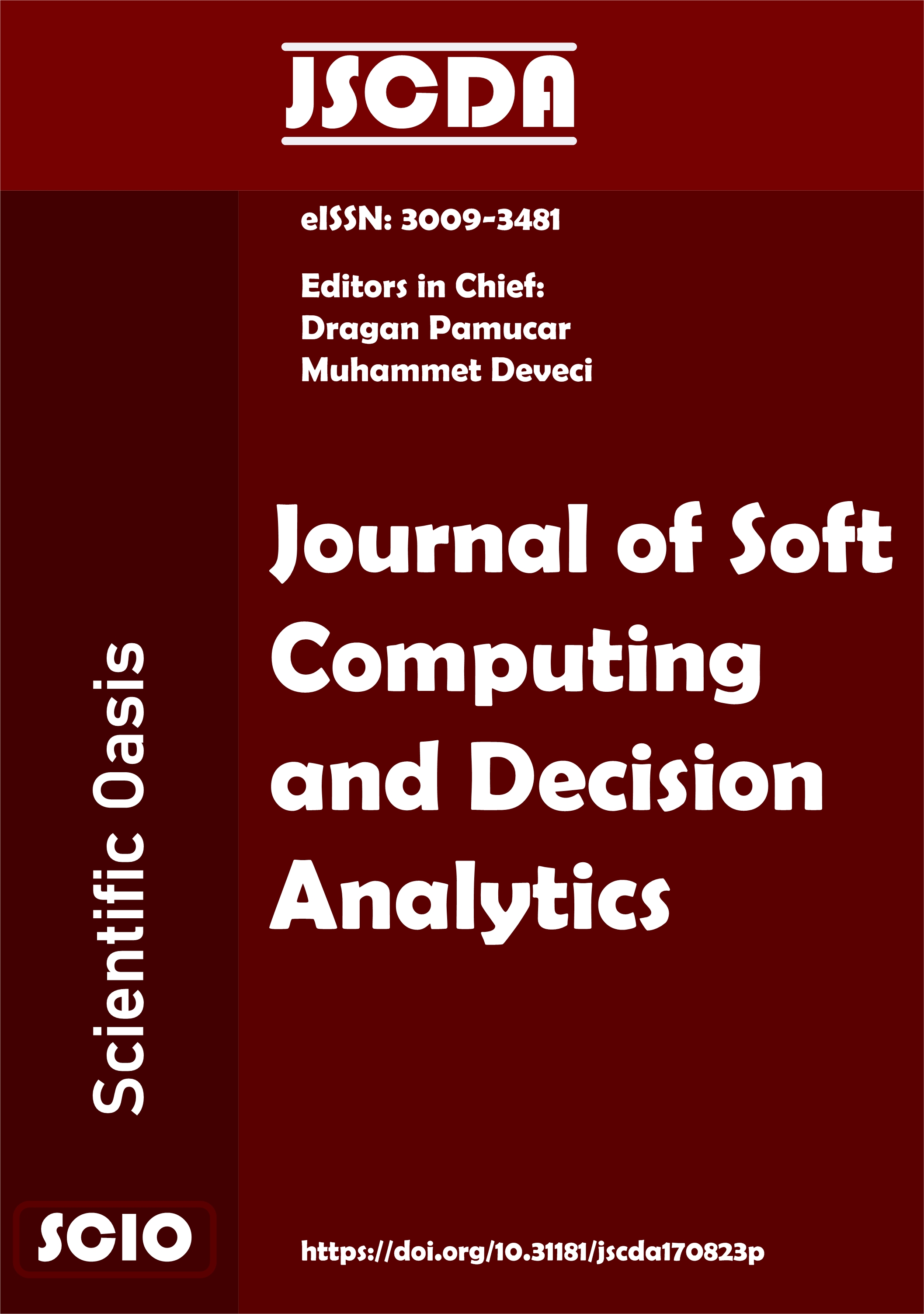A Decision-Making Framework for the Development of Molten-Salt Reactors: Prioritizing Environmental and Technological Factors
DOI:
https://doi.org/10.31181/jscda31202547Keywords:
Energy investments, Nuclear energy projects, Molten-salt reactor, Decision-makingAbstract
The development of molten-salt reactors is of key importance for the development of countries. Although these reactors have many advantages, some issues pose a barrier to the development of these projects. In this context, it is necessary to identify the most important factors affecting the development of molten-salt reactors. This situation allows action to be taken without incurring very high costs. However, there are limited studies in the literature on determining the factors that most affect the performance of these reactors. Accordingly, the purpose of this study is to determine the most significant indicators of molten-salt reactors. In this framework, the main research question is to identify which strategies should be mainly implemented for the improvements of these projects. In the first stage, important variables are determined according to literature review results. Secondly, the weights of these indicators are calculated. In this process, the DEMATEL methodology is taken into consideration. Based on the analysis results, appropriate investment strategies are identified for the improvements of these investments. It is concluded that environmental factors play the most significant issue in the improvements of the molten-salt reactors. In addition to this issue, technological factors are also important for this situation. Nevertheless, social and political factors have the lowest weights in this regard. For the development of molten-salt reactors, improvements in environmental factors must be made first. People's biggest concern about nuclear reactors is the negative effects on the environment. In this context, the radioactive wastes generated may have a negative impact on the environment. This situation negatively affects the image of the projects. In this context, it is appropriate to use thorium instead of uranium in molten-salt reactors. This significantly reduces the amount of radioactive waste generated as a result of the energy production process.
References
Chen, J., & Brooks, C. S. (2024). Modeling of transient and steady state xenon behavior in the molten salt reactor experiment. Annals of Nuclear Energy, 204, 110525. https://doi.org/10.1016/j.anucene.2024.110525
Cui, D. Y., Li, X. X., Dai, Y., Zou, Y., Chen, J. G., & Cai, X. Z. (2024). Accident scenario analysis and control scheme design for a micro–Molten Salt Reactor. Progress in Nuclear Energy, 172, 105208. https://doi.org/10.1016/j.pnucene.2024.105208
Lee, K. O., Jessee, M. A., Graham, A. M., & Kropaczek, D. J. (2024). Coupled neutronics and species transport simulation of the Molten Salt Reactor Experiment. Nuclear Engineering and Design, 417, 112824. https://doi.org/10.1016/j.nucengdes.2023.112824
Chen, L., He, L. Y., Zhou, B., Zhu, G. F., Fan, Y. H., Xu, H. J., ... & Zou, Y. (2024). Evaluation on 131I production based on molten salt reactor off-gas extraction. Annals of Nuclear Energy, 195, 110192. https://doi.org/10.1016/j.anucene.2023.110192
Mishra, V., Elter, Z., Branger, E., Grape, S., & Mirmiran, S. (2024). Irradiated fuel salt data library for a molten salt reactor produced with Serpent2 and SOURCES 4C codes. Data in Brief, 52, 109817. https://doi.org/10.1016/j.dib.2023.109817
Nguyen, T., Merzari, E., Tai, C. K., Bolotnov, I. A., & Jackson, B. (2024). Toward improved correlations for mixed convection in the downcomer of molten salt reactors. Nuclear Technology, 210(7), 1119-1142. https://doi.org/10.1080/00295450.2023.2223036
Wang, Y., Zhu, C., Zhang, M., & Zhou, W. (2024). Molten salt reactors. In Nuclear Power Reactor Designs (pp. 163-183). Academic Press. https://doi.org/10.1016/B978-0-323-99880-2.00009-6
Martin, F., Bergeron, A., Campioni, G., Gorsse, Y., Greiner, N., & Merle, E. (2024). Coupled Neutronics-Thermal-Hydraulic Modeling of a Molten Salt Reactor: The Aircraft Reactor Experiment. Nuclear Science and Engineering, 1-12. https://doi.org/10.1080/00295639.2024.2328964
Harto, A. W., Agung, A., Putra, M. Y. A., & Kanaya, D. J. (2024). Burnup and neutronic parameter analysis of GAMA molten salt reactor (GAMA-MSR). Annals of Nuclear Energy, 207, 110703. https://doi.org/10.1016/j.anucene.2024.110703
Dai, M., & Cheng, M. (2024). A low order MOC-based synthetic acceleration scheme of the MOC neutron transport method for molten salt reactors. Annals of Nuclear Energy, 208, 110789. https://doi.org/10.1016/j.anucene.2024.110789
Wang, Y., Ma, Y., Jiang, N., Zhu, G., Guo, W., Li, J., & Wu, W. (2024). Preliminary analysis of the irradiation deformation of a typical molten salt reactor graphite component. Progress in Nuclear Energy, 168, 105009. https://doi.org/10.1016/j.pnucene.2023.105009
Fang, J., Tano, M., Saini, N., Tomboulides, A., Coppo-Leite, V., Merzari, E., & Shaver, D. (2024). CFD simulations of Molten Salt Fast Reactor core cavity flows. Nuclear Engineering and Design, 424, 113294. https://doi.org/10.1016/j.nucengdes.2024.113294
Li, D. (2024). TRU utilization and MA transmutation in thorium-based fluorinated molten salt fast reactor. Progress in Nuclear Energy, 168, 105015. https://doi.org/10.1016/j.pnucene.2023.105015
Degueldre, C., Findlay, J., Cheneler, D., Sardar, S., & Green, S. (2024). Short life fission products extracted from molten salt reactor fuel for radiopharmaceutical applications. Applied Radiation and Isotopes, 205, 111146. https://doi.org/10.1016/j.apradiso.2023.111146
Brady, C., Murray, W., Moss, L., Zino, J., Saito, E., & Wu, X. (2024). Design considerations and Monte Carlo criticality analysis of spiral plate heat exchangers for Molten Salt Reactors. Progress in Nuclear Energy, 173, 105266. https://doi.org/10.1016/j.pnucene.2024.105266
Larsen, A., Lee, R., Clayton, B., Mercado, E., Wright, E., Edgerton, B., ... & Memmott, M. (2024). Optimization of passive modular molten salt microreactor geometric perturbations using machine learning. Nuclear Engineering and Design, 424, 113307. https://doi.org/10.1016/j.nucengdes.2024.113307
He, Z., Jiang, Y., Chang, L., & Huang, H. (2024). Helium ion irradiation-induced damage of powder metallurgy-hot isostatic pressed Ni-based alloy GH3535 for molten salt reactor applications. Journal of Nuclear Materials, 589, 154871. https://doi.org/10.1016/j.jnucmat.2023.154871
Zeng, Y. S., Zhang, Q., Deng, K., & Liu, W. (2024). A simulation study of tritium distribution in a 10WM (e) thorium-based molten salt reactor. Annals of Nuclear Energy, 197, 110272. https://doi.org/10.1016/j.anucene.2023.110272
Elhareef, M., & Wu, Z. (2024). A new approach to predict pump transient phenomena in Molten salt reactor Experiment (MSRE) by missing data identification and regeneration. Nuclear Engineering and Design, 424, 113292. https://doi.org/10.1016/j.nucengdes.2024.113292
Huang, J. L., Jia, G. B., Han, L. F., Liu, W. Q., Huang, L., & Yang, Z. H. (2024). Dynamic simulation analysis of molten salt reactor-coupled air–steam combined cycle power generation system. Nuclear Science and Techniques, 35(2), 30. https://doi.org/10.1007/s41365-024-01394-5
Aysan, A. F., Yüksel, S., Eti, S., Dinçer, H., Akin, M. S., Kalkavan, H., & Mikhaylov, A. (2024). A unified theory of acceptance and use of technology and fuzzy artificial intelligence model for electric vehicle demand analysis. Decision Analytics Journal, 11, 100455. https://doi.org/10.1016/j.dajour.2024.100455
Ecer, F., Ögel, İ. Y., Dinçer, H., & Yüksel, S. (2024). Assessment of Metaverse wearable technologies for smart livestock farming through a neuro quantum spherical fuzzy decision-making model. Expert Systems with Applications, 255, 124722. https://doi.org/10.1016/j.eswa.2024.124722
Kou, G., Pamucar, D., Dinçer, H., Deveci, M., Yüksel, S., & Umar, M. (2024). Perception and expression-based dual expert decision-making approach to information sciences with integrated quantum fuzzy modelling for renewable energy project selection. Information Sciences, 658, 120073. https://doi.org/10.1016/j.ins.2023.120073
Eti, S., Yüksel, S., Dinçer, H., Kalkavan, H., Hacioglu, U., Mikhaylov, A., ... & Pinter, G. (2024). Assessment of technical and financial challenges for renewable energy project alternatives. Cleaner Engineering and Technology, 18, 100719. https://doi.org/10.1016/j.clet.2023.100719
Lobo, M. C., & de Stefani, G. L. (2024). Thorium as nuclear fuel in Brazil: 1951 to 2023. Nuclear Engineering and Design, 419, 112912. https://doi.org/10.1016/j.nucengdes.2024.112912
Kamarudin, N. A. Z., Ismail, A. F., Rabir, M. H., & Siong, K. K. (2024). Neutronic optimization of thorium-based fuel configurations for minimizing slightly used nuclear fuel and radiotoxicity in small modular reactors. Nuclear Engineering and Technology. https://doi.org/10.1016/j.net.2024.02.023
Akbari, R., Nasr, M. A., D'Auria, F., Cammi, A., Maiorino, J. R., & de Stefani, G. L. (2024). Analysis of thorium-transuranic fuel deployment in a LW-SMR: A solution toward sustainable fuel supply for the future plants. Nuclear Engineering and Design, 421, 113090. https://doi.org/10.1016/j.nucengdes.2024.113090
Downloads
Published
Issue
Section
License
Copyright (c) 2025 Scientific Oasis

This work is licensed under a Creative Commons Attribution-NonCommercial-NoDerivatives 4.0 International License.
















